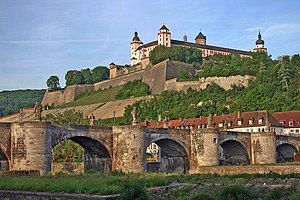Fortress Marienberg
| Marienberg Fortress | |
|---|---|
| Festung Marienberg | |
| Near Würzburg, Germany | |

Fortress Marienberg and the Old Bridge
|
|
| Coordinates | 49°47′23″N 9°55′17″E / 49.789722°N 9.921389°E |
| Type | Fortress |
| Site information | |
| Owner | Bavarian Administration of State-Owned Palaces, Gardens and Lakes |
| Open to the public |
Yes |
| Site history | |
| Built | mostly 13th to 18th century |
| Built by | Bishops of Würzburg |
Marienberg Fortress (German: Festung Marienberg) is a prominent landmark on the left bank of the Main river in Würzburg, in the Franconia region of Bavaria, Germany. The mighty Fortress Marienberg is a symbol of Würzburg and served as a home of the local prince-bishops for nearly five centuries. It has been a fort since ancient times. Most of the current structures originally were built in Renaissance and Baroque styles between the 16th and 18th centuries. After Gustavus Adolphus of Sweden conquered the area in 1631 during the Thirty Years' War, the castle was reconstructed as a Baroque residence. After it ceased to serve as residence of the Bishops of Würzburg, the fortress saw repeated action in the wars of the late 18th and 19th centuries. Festung Marienberg was severely damaged by British bombs in March 1945 and only fully rebuilt in 1990. Today, it houses two museums.
The fortress is located on a prominent spur of the 266 metre high Marienberg which rises about 100 metres over the Main river on the opposite side of the city of Würzburg. On the slopes around the castle are vineyards.
Around 1000 BC, a Celtic refuge castle was built on the site by members of the Urnfield culture. Archaeological findings indicate that the locals of the later Hallstatt culture had trade contacts with Ancient Greece and marked an extreme northern point on the wine trade network of the time circa 500 BC. The hill may have been a Fürstensitz, the seat of a "prince".
From 100 AD onwards control of the area changed hands several times between different "tribes" (Suevi, Marcomanni, Allemanni, Burgundians), before the area was taken by the Franks in the 6th century. Würzburg became the occasional seat of a Franconian-Thuringian duke under the Merovingians. His court resided on the right bank of the Main, however. In the 7th century, a written document mentioned Uburzi (which later became Virteburch and then "Würzburg"), referring to the fortification on the hill. The name Marienberg was in use only from high medieval times onward. After missionary work in the area led by Saint Kilian in the late 7th century, in the early 8th century, the Franks under Duke Hedan II constructed a chapel dedicated to the Virgin Mary and a fortification (earth ramparts and half-timbered houses) on the hill. The chapel - probably built at the site of a former pagan holy site dedicated to some mother goddess - and later churches that replaced it, was the reason why eventually hill and fortress became known as Marienberg ("Mary's Mount"). This likely was the first Christian church built of stone north of the Alps outside of the territory formerly controlled by Rome (i.e. east of the Rhine and on the far side of the Limes).
...
Wikipedia

